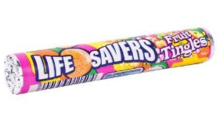
Gummy bears are small, fruit gum candies, similar to a jelly baby in some English-speaking countries. The candy is roughly 2 cm (0.8 in) long and shaped in the form of a bear. The gummy bear is one of many gummies, popular gelatin-based candies sold in a variety of shapes and colors.

Kit Kat is a chocolate-covered wafer bar confection created by Rowntree's of York, United Kingdom. It is produced globally by Nestlé, except in the United States, where it is made under licence by the H. B. Reese Candy Company, a division of the Hershey Company.
White Knight is a brand of chocolate-coated, chewy, mint-flavoured confectionery bar sold in Australia. Originally produced by Hoadley's Chocolates it was later manufactured by Nestlé Australia. The packaging is blue and white and features a picture of a knight on a horse. Its slogan is 'Mighty Mint Chew'. The product was discontinued in 2016.
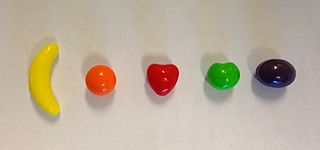
Runts are crunchy candies sold by Ferrara Candy Company. First seen on the market in 1982, the candies are in the shape, color, and flavor of a selection of fruits. Runts have a hard candy shell with a compressed dextrose center.
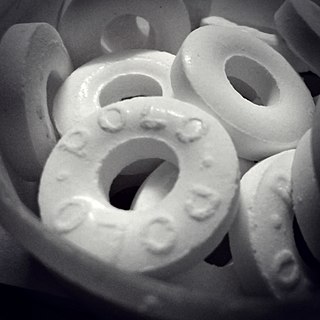
Polo is a brand of breath mint whose defining feature is the hole in the middle. The peppermint flavoured Polo was first manufactured in the United Kingdom in 1948, by employee John Bargewell at the Rowntree's Factory, York, and a range of flavours followed. The name may derive from "polar", referencing the cool, fresh taste of the mint. Polo mints are also sold in other countries such as India and Sri Lanka by Nestlé. Polo mints are usually sold in a 34g pack containing 23 individual mints.

Life Savers is an American brand of ring-shaped hard and soft candy. Its range of mints and fruit-flavored candies is known for its distinctive packaging, coming in paper-wrapped aluminum foil rolls.
Laffy Taffy is an American brand of taffy candies produced by the Ferrara Candy Company, a subsidiary of Ferrero. The candies are small, individually wrapped taffy rectangles available in a variety of colors and fruit flavors, including banana, strawberry, green apple, grape, blueberry, watermelon, blue raspberry, and cherry. Rarer flavors include caramel apple, coconut, strawberries & cream, apple crisp, chocolate mousse, pumpkin donut, pineapple, guava, orange sorbet, and lemon raspberry. Discontinued flavors include fruit punch, mango, strawberry banana, peppermint, and hot cocoa.

After Eight Mint Chocolate Thins, often referred to as simply After Eights, are a brand of mint chocolate covered sugar confectionery. They were created by Rowntree Company Limited in the UK in 1962 and have been manufactured by Nestlé since its acquisition of Rowntree in 1988.

Maltesers are a British confectionery product manufactured by Mars, Incorporated. First sold in the UK in 1937, they were originally aimed at women. They have since been sold in Europe, Australia, New Zealand, Canada, United States and Middle East. The slogan is "The lighter way to enjoy chocolate".

Liquorice or licorice is a confection usually flavoured and coloured black with the extract of the roots of the liquorice plant Glycyrrhiza glabra.
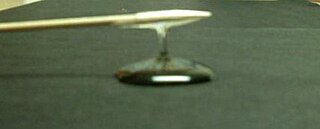
Glucose syrup, also known as confectioner's glucose, is a syrup made from the hydrolysis of starch. Glucose is a sugar. Maize (corn) is commonly used as the source of the starch in the US, in which case the syrup is called "corn syrup", but glucose syrup is also made from potatoes and wheat, and less often from barley, rice and cassava.p. 21

Rowntree's Fruit Pastilles are small round sweets measuring about 1.5 cm (0.6 in) in diameter; they have a jelly-like consistency, and are covered with sugar. They contain fruit juice, have no artificial colours or flavours, and come in five flavours: lemon (yellow), lime (green), strawberry (red), blackcurrant (purple) and orange (orange).

Nestlé UK Ltd., trading as Rowntree's, is a British confectionery brand and a former business based in York, England. Rowntree developed the Kit Kat, Aero, Fruit Pastilles, Smarties brands, and the Rolo and Quality Street brands when it merged with Mackintosh's in 1969 to form Rowntree Mackintosh Confectionery. Rowntree's also launched After Eight thin mint chocolates in 1962. The Yorkie and Lion bars were introduced in 1976. Rowntree's also pioneered the festive selection box which in the UK have been a staple gift at Christmas for over a century.

Creamola Foam was a soft drink produced in the form of effervescent crystals that were mixed with water. It was manufactured in Glasgow and sold in the UK from the 1950s, until Nestlé ended production in October 1998.
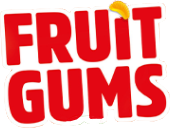
Rowntree's Fruit Gums are circular sweets formerly made by Rowntree's, who were later acquired by Nestlé. There are five flavours, each of a different colour: strawberry, orange, lemon, blackcurrant, and lime.

Double Dip is a confectionery produced by Swizzels Matlow, where it has been popular in the United Kingdom, Australia and Germany. Towards the end of the 1980s Double Dip hit its peak of popularity when the sherbet based confection became the best selling sweet in Ireland.

Midget Gems are chewy, firm sweets similar to wine gums but much harder. They are manufactured from sugar and glucose syrup, corn starch and/or various other starches, animal gelatin, and various colourings and flavouring.
Wonka Gummies are a line of gummy sweets made by The Willy Wonka Candy Company. They were launched in 2009 and are available in 155.9g/5.5 ounce bags. The Sluggles, Puckerooms, Wingers, and Sploshberries were previously marketed as coming from Wonka's edible garden, up until November 2010.
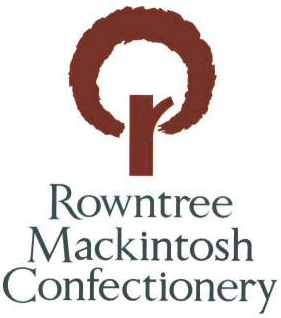
Rowntree Mackintosh plc, trading as Rowntree Mackintosh Confectionery, was an English confectionery company based in York, England. It was formed by the merger of Rowntree's and John Mackintosh Co. The company was famous for making chocolate brands, such as Kit Kat, Aero and Quality Street. It was purchased by Nestlé in 1987, with products rebranded under its own brand.
